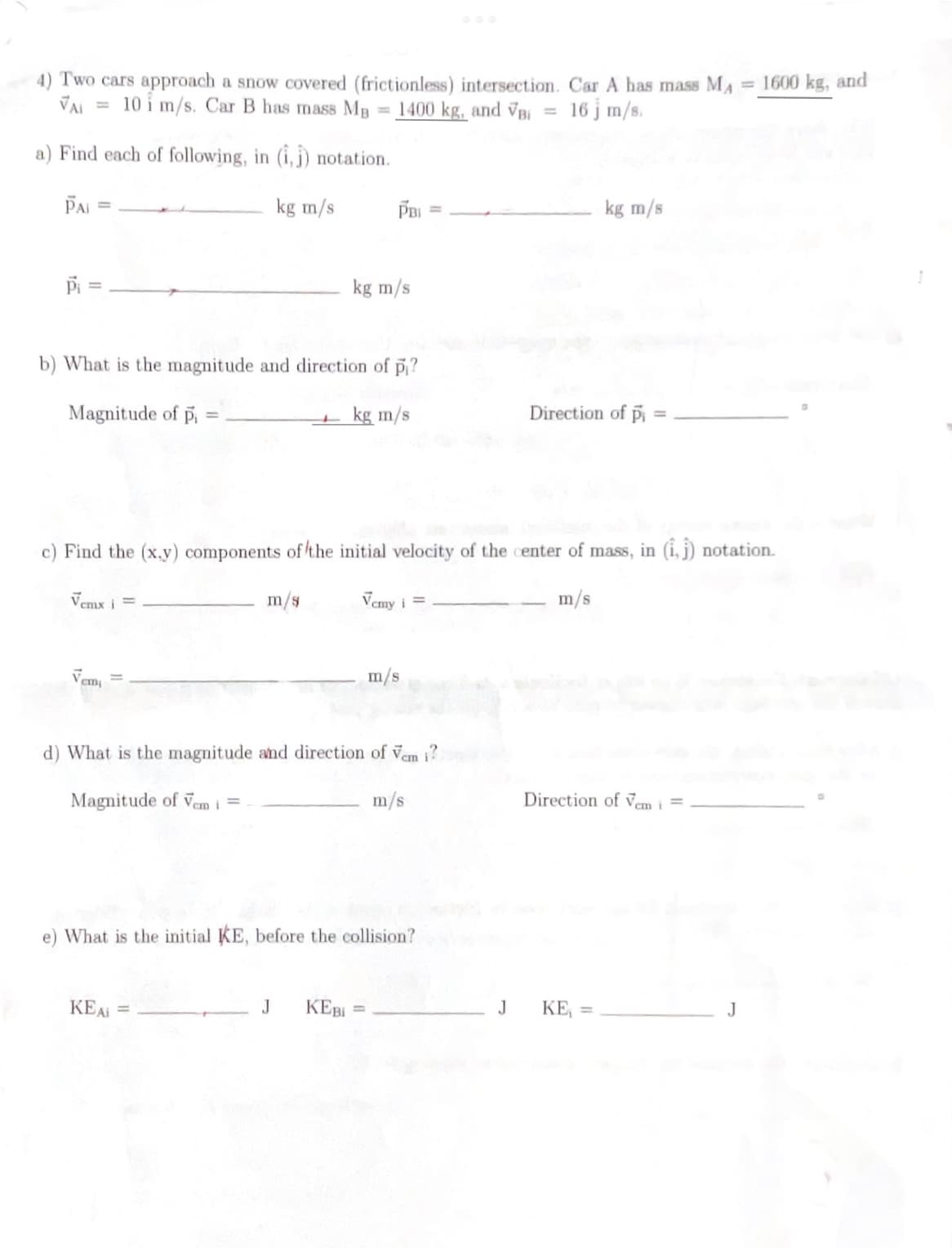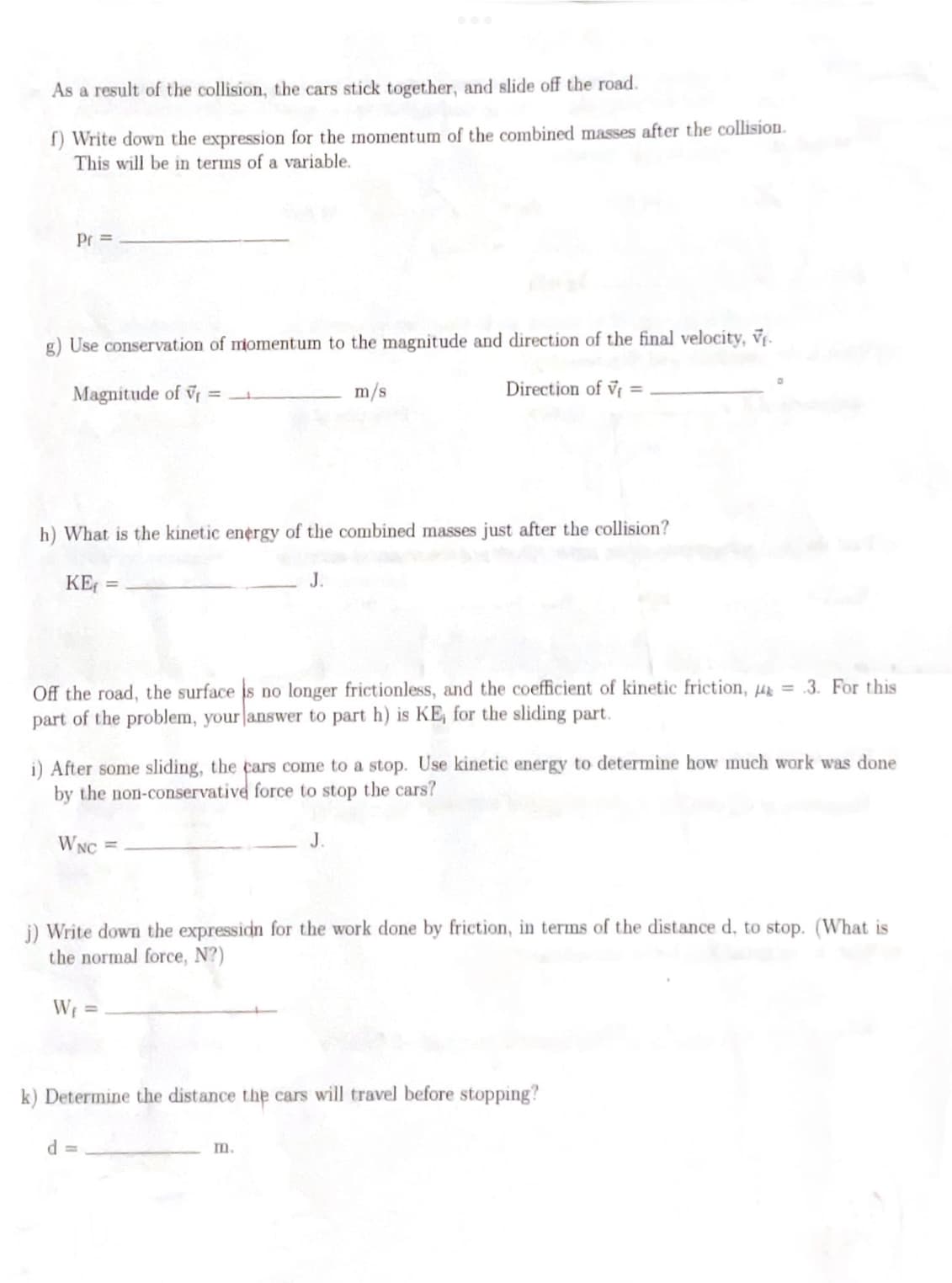4) Two cars approach a snow covered (frictionless) intersection. VAI 10 i m/s. Car B has mass MB 1400 kg, and VB = a) Find each of following, in (1,1) notation. kg m/s PAI Pi b) What is the magnitude and direction of pi? Magnitude of p = Vemx i = PBI Vemi kg m/s m/s kg m/s c) Find the (x,y) components of the initial velocity of the center of mass, in (1,1) notation. Vemy i = m/s m/s Car A has mass MA = 1600 kg, and 16 j m/s. d) What is the magnitude and direction of Vem i? Magnitude of Vem i = m/s kg m/s Direction of pi = Direction of Vem i = cm
4) Two cars approach a snow covered (frictionless) intersection. VAI 10 i m/s. Car B has mass MB 1400 kg, and VB = a) Find each of following, in (1,1) notation. kg m/s PAI Pi b) What is the magnitude and direction of pi? Magnitude of p = Vemx i = PBI Vemi kg m/s m/s kg m/s c) Find the (x,y) components of the initial velocity of the center of mass, in (1,1) notation. Vemy i = m/s m/s Car A has mass MA = 1600 kg, and 16 j m/s. d) What is the magnitude and direction of Vem i? Magnitude of Vem i = m/s kg m/s Direction of pi = Direction of Vem i = cm
University Physics Volume 1
18th Edition
ISBN:9781938168277
Author:William Moebs, Samuel J. Ling, Jeff Sanny
Publisher:William Moebs, Samuel J. Ling, Jeff Sanny
Chapter9: Linear Momentum And Collisions
Section: Chapter Questions
Problem 96AP: Two carts on a straight track collide head on. The first cart was moving at 3.6 m/s in the positive...
Related questions
Topic Video
Question
Not understanding A-K need help

Transcribed Image Text:4) Two cars approach a snow covered (frictionless) intersection. Car A has mass MA = 1600 kg, and
VAI
10 i m/s. Car B has mass MB
1400 kg, and VB =
16 j m/s.
a) Find each of following, in (1,1) notation.
kg m/s
PAI =
Pi
Vemx i =
b) What is the magnitude and direction of pi?
Magnitude of pi
kg m/s
cm¡
=
m/s
PBI
kg m/s
c) Find the (x,y) components of the initial velocity of the center of mass, in (1,1) notation.
Vemy i =
m/s
KEAi =
d) What is the magnitude and direction of Vem i?
Magnitude of Vem i =
m/s
J KEBI=
m/s
e) What is the initial KE, before the collision?
J
kg m/s
Direction of pi
Direction of Vem i =
KE₁ =

Transcribed Image Text:As a result of the collision, the cars stick together, and slide off the road.
f) Write down the expression for the momentum of the combined masses after the collision.
This will be in terms of a variable.
Pr =
g) Use conservation of momentum to the magnitude and direction of the final velocity, V₁.
Magnitude of V=____
m/s
h) What is the kinetic energy of the combined masses just after the collision?
KE₁ =
Off the road, the surface is no longer frictionless, and the coefficient of kinetic friction, 4 = .3. For this
part of the problem, your answer to part h) is KE, for the sliding part.
Direction of V
i) After some sliding, the cars come to a stop. Use kinetic energy to determine how much work was done
by the non-conservative force to stop the cars?
WNC
J.
j) Write down the expression for the work done by friction, in terms of the distance d, to stop. (What is
the normal force, N?)
W₁ =
d=
k) Determine the distance the cars will travel before stopping?
m.
Expert Solution
This question has been solved!
Explore an expertly crafted, step-by-step solution for a thorough understanding of key concepts.
This is a popular solution!
Trending now
This is a popular solution!
Step by step
Solved in 4 steps with 3 images

Knowledge Booster
Learn more about
Need a deep-dive on the concept behind this application? Look no further. Learn more about this topic, physics and related others by exploring similar questions and additional content below.Recommended textbooks for you

University Physics Volume 1
Physics
ISBN:
9781938168277
Author:
William Moebs, Samuel J. Ling, Jeff Sanny
Publisher:
OpenStax - Rice University

Physics for Scientists and Engineers, Technology …
Physics
ISBN:
9781305116399
Author:
Raymond A. Serway, John W. Jewett
Publisher:
Cengage Learning

Physics for Scientists and Engineers with Modern …
Physics
ISBN:
9781337553292
Author:
Raymond A. Serway, John W. Jewett
Publisher:
Cengage Learning

University Physics Volume 1
Physics
ISBN:
9781938168277
Author:
William Moebs, Samuel J. Ling, Jeff Sanny
Publisher:
OpenStax - Rice University

Physics for Scientists and Engineers, Technology …
Physics
ISBN:
9781305116399
Author:
Raymond A. Serway, John W. Jewett
Publisher:
Cengage Learning

Physics for Scientists and Engineers with Modern …
Physics
ISBN:
9781337553292
Author:
Raymond A. Serway, John W. Jewett
Publisher:
Cengage Learning

Physics for Scientists and Engineers
Physics
ISBN:
9781337553278
Author:
Raymond A. Serway, John W. Jewett
Publisher:
Cengage Learning


College Physics
Physics
ISBN:
9781305952300
Author:
Raymond A. Serway, Chris Vuille
Publisher:
Cengage Learning